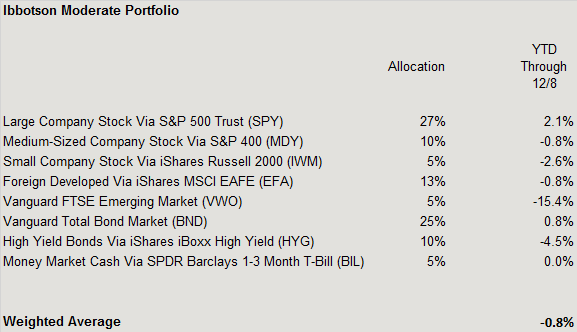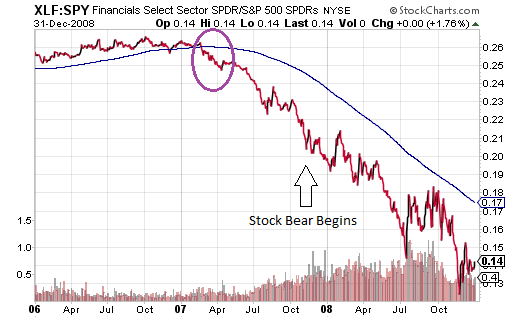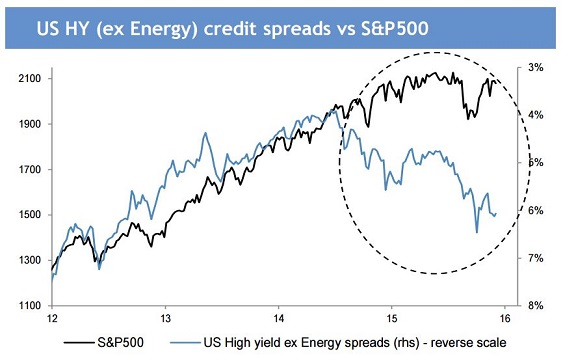Ibbotson Associates provides asset allocation guidelines that span the risk spectrum from conservative to aggressive. The moderate portfolio consists of roughly 42% in U.S. Stock, 18% in Non-U.S. Stock, 35% Fixed Income and 5% in Cash.
It follows that the static Ibbotson model might employ the following ETFs to achieve its moderate growth and income aim:

With flat to slightly negative returns, one could make the case that diversification is working just fine. On the other hand, the more that one has minimized the downside risk of investment canaries in the financial mines – high yield credit, emerging markets and smaller corporations – the more one has been able to relax. An allocation of 60% in large-cap U.S. stocks (N:SPY) and 40% investment grade U.S. bonds (N:BND) improved performance to 1.6% – a swing of 240 basis points.
An argument in favor of diversification across asset class segments is that, if one holds recommended percentages for the next 20 years, recent underperformers will provide value down the road. Moreover, the combination of the above-mentioned asset types performed better than an ethnocentric large-cap-only allocation (60% S&P 500, 40% Barclays (L:BARC) Aggregate Bond Index) over the previous 20 years.
Here’s the problem: There are times when the breakdown in an asset grouping and/or an influential sector(s) of an economy is symptomatic of larger issues for market-based securities.
For instance, the collapse of the banking system in 2008 had been telegraphed by financial stock woes nearly a year beforehand. The SDPR Select Sector Financials ETF (N:XLF):S&P 500 SPDR Trust (SPY) price ratio had been highlighting the rapid-fire demise of financial stocks relative to the broader benchmark. (Note: Back in 2007, “ex Financials” was the popular excuse offered to dismiss S&P 500 overvaluation; in 2015, many are using “ex Energy” to justify S&P 500 overvaluation.)

There’s more. Even as SPY notched new record highs in October of 2007, other asset groupings did not recapture highs set in July of 2007. Small companies via iShares Russell 2000 (N:IWM) did not make it back. In the fixed income space, preferred shares via iShares Preferred Stock (N:PFF) were weakening as well.

In the last year of the previous bull market (2007), lightening up on smaller companies, higher-yielding preferred shares as well as the financial sector benefited investors. Here in 2015, lightening up on smaller company stock (N:IWM), foreign developed stock (N:EFA), emerging markets (N:VWO) and high yield bonds (N:HYG) has also been beneficial. For one thing, each of these asset types sits below long-term 200-day averages – a bearish sign for these asset classifications. Secondly, even when one excludes energy from the high yield bond picture, “ex Energy” spreads have been diverging from the S&P 500 throughout the year.

Based on the evidence, moderate growth investors who choose an allocation of 60% in large-cap U.S. stocks and 40% investment grade U.S. bonds are likely to outperform the static Ibbotson model in the near-term. One might consider spreading the large-cap exposure across several ETFs such as iShares S&P 500 (N:IVV), iShares S&P 100 (N:OEF), SPDR Select Technology (N:XLK), iShares Russell 1000 Growth (N:IWF) and iShares USA Minimum Volatility (N:USMV).
I have had virtually no allocation to small caps, high yield bonds or emerging market stocks during this late-stage bull market. All of those areas remain mired in long-term technical downtrends. In addition, I have only 25% allocated to investment grade bonds with another 15% in cash/cash equivalents.
If market internals continue to deteriorate and if the macro-economic backdrop continues to weaken, a tactical asset allocation decision to reduce the risk of exposure to extremely overpriced U.S. stocks may be called for. Make no mistake about it… large-cap U.S. stocks are overpriced. Year-over-year, corporate earnings have fallen from a height of $106 on 9/30/2014 for the S&P 500 to the most recent estimate just shy of $91 (October 2015). That is a decline of approximately 14%. The earnings contraction over multiple quarters with the TTM P/E Ratio at 22.7 is well above the average since 1870 of 16.6.
For those who would rather embrace Forward P/Es, Birinyi Associates at WSJ.com estimates a value of 17.4. This implies that $91 is going to be $121 in the next 12 months. Short of a miraculous revival in energy demand, 33% earnings growth is not particularly plausible. Even a forward P/E of 17.4 is 25% higher than the 35-year average forward P/E of 13.
Overvaluation by itself is not a reason to reduce exposure to large caps. A late-stage bull market could continue for several more years; highly priced can become exorbitant. That said, if an economic slowdown becomes an economic standstill, and if the number of large company stocks holding up the market-cap weighted indexes further retrenches, reducing one’s overall equity profile and raising one’s cash level is sensible.
Keep in mind, positions that haven’t been working (e.g., high yield bonds, small caps, emerging markets, etc.) will probably cause even greater pain when the market falls. It is critical to keep losses small. Similarly, it is constructive to exercise a methodical approach to raising cash as a late stage bull market carries on. Having some cash available is the way to purchase investments at a better price in the future. Indeed, there’s a reason that one of the premier rules for investing rule is “Sell High, Buy Low.”
Disclosure: Gary Gordon, MS, CFP is the president of Pacific Park Financial, Inc., a Registered Investment Adviser with the SEC. Gary Gordon, Pacific Park Financial, Inc, and/or its clients may hold positions in the ETFs, mutual funds, and/or any investment asset mentioned above. The commentary does not constitute individualized investment advice. The opinions offered herein are not personalized recommendations to buy, sell or hold securities. At times, issuers of exchange-traded products compensate Pacific Park Financial, Inc. or its subsidiaries for advertising at the ETF Expert web site. ETF Expert content is created independently of any advertising relationships.
